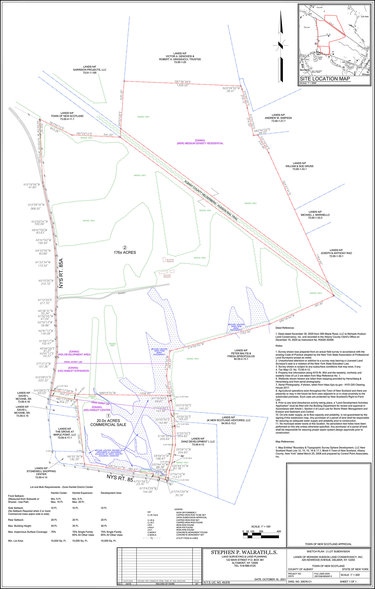New Scotland’s yearslong planning starts to pay dividends
NEW SCOTLAND — After being chastised by political rivals for years, town officials’ vision for parts of New Scotland are finally coming to fruition.
The New Scotland Planning Board at its November meeting began the process of subdividing the former Bender melon farm into preservable and commercially-viable parcels.
Last December, the Mohawk Hudson Land Conservancy paid $1 million for the 176-acre property at the corner of routes 85 and 85A, according to the deed filed with the Albany County Clerk.
To help pay for the purchase, the conservancy will sell to a commercial interest 20 of those acres along Route 85, across the road from the Stewart’s Shop and gas station and with access from Maple Road. The land is listed on New Scotland’s assessment rolls with a full-market value of $807,363, and was previously listed for sale as a commercial use for $4 million.
Supervisor Douglas LaGrange said during an Enterprise candidates’ forum in October that Ron Kay had bought the 20 acres of land from the conservancy.
Kay is the developer of a 3.2-acre property between Fred the Butcher and Stonewell Plaza. Originally proposed in 2o16 as a mixed-use development with 30 apartment units and 16,000 square feet of retail space, the current project was scaled back, leaving just the retail intact. The original design would have required a substantial and expensive sewer-district extension; the approved plan uses a septic system.
Kay did not return a call for an interview.
Since it’s actually a minor subdivision, the town’s building inspector, Jeremy Cramer, could have approved the subdivision himself — but for transparency purposes, because what is being subdivided is almost entirely the remaining vacant land in the Hamlet Development Center, “we wanted to push it to the planning board for their approval,” Cramer said during the planning board’s Nov. 9 meeting.
In 2018, the town board adopted new zoning for the area, dubbed the New Scotland Hamlet Zoning District.
The plan ascribes specific “character areas,” or sub-districts, to the hamlet:
— Beginning with a concentrated hamlet center that will have the character of a traditional village development, including a central area for greenspace. This will be mostly commercial space, but could also include multi-family housing that is incorporated into mixed-use development, which would have commercial space on the ground level. In the plan, this area covers the corner of routes 85 and 85A, extending to Fred the Butcher to the north and extending past Stewart’s to the east;
— Radiating out from the hamlet center, south of route 85 and extending west across Route 85A to the railroad tracks and north a few hundred feet past Fred the Butcher, is the hamlet-expansion area, which is now zoned for mixed-use land use to incorporate more housing in the area; and
— The hamlet development area extends north to the rail trail and crosses over to the west of route 85 to the LeVie Farm housing development and extends east to existing, developed land. This area would include more residential space than commercial.
“What this does is this allows us a fairly significant piece of land dedicated to the Hamlet Center Zone, which was anticipated in the comprehensive plan,” Chairman Charles Voss said during the meeting. “So we’re starting to see, you know, those pieces fall into place now — slowly ... Certainly, it makes a lot of sense. And it’s, I think, a great move in terms of allowing the town to begin that slow expansion of our commercial zone.”
Garrett Frueh, the town’s engineer, had a question for the board: What is the town’s intent for commercial development on the site?
There are six acres of wetlands on the 20-acre parcel, Frueh said. “And the way that the wetlands are shaped, [they] are definitely going to provide some obstacles, if the goal is to get some commercial development on that lot.”
Voss said, “I think that’s a question maybe for another day.”
Board member Christine Galvin said it was a “question for the purchaser.”
When a minor subdivision is referred to the planning board, the town’s zoning law requires a public hearing on the proposed subdivision, which the board set for Dec. 7.
For notice of the public hearing, the planning board typically notifies property owners within 1,000 feet of the property, which Cramer said is the town law, but state law says 500 feet is satisfactory — the planning board went with 500 feet for the 176-acre parcel.



